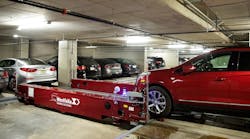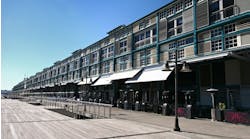Evolving technologies and the endless implications of the Internet of Things for human convenience are making its way into every sector of our daily lives—from your smartphone-enabled thermostat to self-driving vehicles, and now, automating the daily routine of parking. This means large-scale automation for parking garages and, yes, even apps for your smartphone to help you park.
Automated Storage/Retrieval Systems (AS/RS) is a technology that has traditionally been used for storing goods in the manufacturing and warehousing process, but it’s now revolutionizing the challenging world of parking. These systems are completely automated, allowing patrons to drop off and pick up their vehicles in a contactless, safe and secure way within a central transfer location. Automated parking garages are not only a more convenient form of parking, but also help address a wide array of issues including urban sprawl, architectural design, land use and climate change.
With consumers embracing and even anticipating these new technologies, many building owners and developers are reshaping the future of parking facilities. The subsequent shift in expectations for parking garage and building owners have them rethinking the benefits of automated parking in four significant ways.
[Related: Office Matters, Part 1: Reviving Work at the Office]
1. Better Building Options
Real estate professionals, architects and developers can all benefit from automated parking systems as they help to create innovative, functional and aesthetically pleasing options for new property designs by completely eliminating the need for ramps, stairwells and maneuvering space, thereby creating opportunities for:
- Preserving city landscapes: Automated parking systems allow for greater freedom to create unique garage designs and encourage underground facilities by reducing excavation requirements, helping preserve classic cityscapes.
- Cost savings during construction: Since automated parking facilities require less space, this means shorter construction times, less excavation and reduced land use—all working together to produce significant cost savings for builders, owners and architects.
- Greater flexibility: Space savings also allow for more room to add more rentable space, be it mixed-use, residential or commercial facilities—boosting profits for developers and building owners.
2. A Standard of Sustainability
The future of the auto industry is transitioning to a long-anticipated exodus from fossil fuels to more sustainable forms of energy. In 2020, EV global sales reached $2.5 million and continues to grow, with U.S. regulations calling on half of all vehicles sold to be electric by 2030. Already witnessing global repercussions, current and future parking facilities need to integrate electric vehicle (EV) charging stations to be viable for tomorrow’s drivers, especially in densely populated areas.
An automated parking facility can minimize the electrical service requirements for EV chargers, as vehicles within an automated parking system can be moved to and from charging positions to be charged rather than having chargers or supply equipment for every EV parking space.
Automated parking facilities eliminate the need to drive around in circles and endlessly search for a parking space. With automated parking, drivers spend less time behind the wheel idling—and therefore reduce emissions. Environmental considerations are paramount in future building design and LEED certification. Considering that transportation is the cause for a fifth of all global emissions, any technology that gets drivers on and off the road faster is ultimately more sustainable and more attractive to future drivers.
[Related: When Urban Infill Becomes a Matter of Parks and Rec]
3. The Value of Land and the Desire for Green Space in Urban Areas
Typically, twice as many vehicles can be parked within an automated parking facility than in a traditional parking garage—utilizing the same amount of space, but significantly reducing land use. This frees up land to be used for further project development or green space.
Land is immensely valuable. Some estimates suggest that there are 2 billion parking spots in the U.S. and 300 million in western Europe, and vehicle purchases aren’t halting anytime soon. In densely populated cities across the globe, much of the budget and extremely valuable land space is dedicated to the daily inconvenience of parking.
Creating and preserving green space in busy cities and congested areas has become a growing trend globally, especially in Europe. Green space and property values for private residences and brick and mortar businesses are directly correlated—and for good reason. According to the World Health Organization, urban green space not only looks great, but is linked to improved health and wellness for those around it.
Reducing the amount of space it takes to park vehicles is vital to the future of parking, especially when considering population migration projections around the world. According to a UN report, 68% of all people are expected to live in cities by 2050. While COVID-19 undoubtedly slowed population growth in some cities, the parking issues remain the same: too much land is used for parking that could be better utilized to develop more sustainable, greener urban environments.
4. Increasing Driver Safety and Convenience
Traditional parking garages are known to be frustrating and unsafe. There are more than 50,000 parking lot accidents each year in the U.S., which results in more than 60,000 injuries and as many as 500 deaths. However, automated parking systems provide a safe and convenient user experience. There is no need to navigate a multi-level parking facility to recover vehicles or worry about property damage.
Instead, patrons can retrieve their vehicles with their smartphone within a secure pick-up/drop-off area. When it comes to automated parking, there is indeed an app for that. These apps allow drivers to schedule a time to retrieve their vehicle and remotely track it live as it’s delivered to the loading area, eliminating unnecessary waiting time at the garage.
Automated parking technology is undoubtedly the way of the future. The sleek aesthetics, variety of building options, focus on sustainability and land use, and increased safety and convenience makes automated parking an attractive solution to today’s parking challenges.
About the Author:
Ian Todd is the director of automated parking systems for Westfalia Technologies, Inc.
Read more: The Flight 93 National Memorial Honors the Heroes of 9/11 and Helps Heal the Land



